Please support Game Informer. Print magazine subscriptions are less than $2 per issue
Exclusive Hands-On Impressions Of Spider-Man
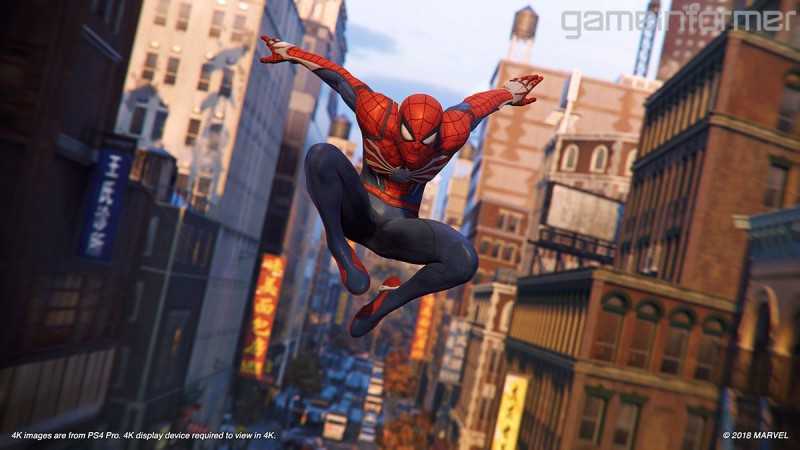
Since its announcement in 2016, Insomniac has been quiet about Spider-Man. We’ve seen a few trailers, a few screens, and at E3 2017 we got to see some extended gameplay on Sony’s press-conference stage – but it didn’t venture too far into Spider-Man’s version of New York and focused mostly on story and combat. For our May issue of the magazine, Insomniac let us into its studio to talk with the team extensively about the game, but more importantly, they let us play it. We went hands-on with the opening, got into some fights, and did the thing I wanted to do more than anything else: web-swing through the open city.
The Web-Swinging
My personal interest in Insomniac’s take on Spider-Man revolves almost entirely around the web-swinging. I look forward to beating up bad guys and seeing where the story goes as it follows this older, more mature version of Peter Parker, but web-swinging is the activity I love most about Spider-Man games. It’s the thing that could easily make or break this new direction for the character. Any hesitancy I had about how web-swinging would work was quickly squashed, however, when we asked creative director Bryan Intihar if webs will stick to buildings. “They better if I want this game to sell at all,” he replied somewhat sarcastically.
Games like Assassin’s Creed, which similarly rely on open-world movement as a factor of fun, but in a very different way, have increasingly simplified the process of moving with each sequel, sacrificing full control in favor of smoother parkour. That isn't the case here, as web-swinging is an active process. It's not complicated, but the door has been left open so players can perform impressive movements that require frequent input.
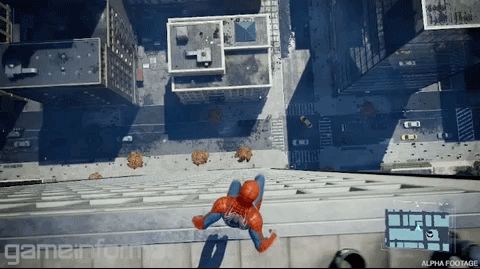
As promised, webs do stick to buildings when you throw them out and physics are an important factor. Where you leave the swing changes Spider-Man’s trajectory. If you leave at the bottom of the swing you move farther forward. If you leave on an upward trajectory, Spider-Man flies higher. You can also press web-zip without having a web attached to a building to make Spider-Man throw out two webs and pull himself forward, and you can use that maneuver to make sharp turns, or even U-turns.
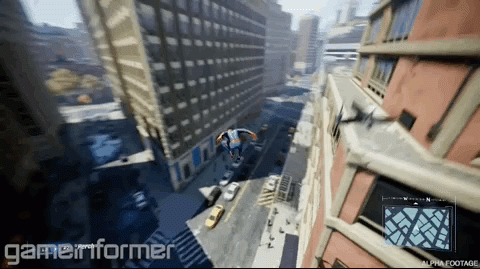
Spider-Man can also perch atop tons of specific points on buildings and street signs and use them as launch-pads, or just as a place to sit and take in the city. He can also run along walls and parkour over obstacles. Perches are highlighted by small white circles in front of you, giving you a quick but clear understanding of what you can latch onto or fling off of. If Spider-Man is running up a wall and you jump at the top of the building at the right moment, he will vault over it in an impressive arc.
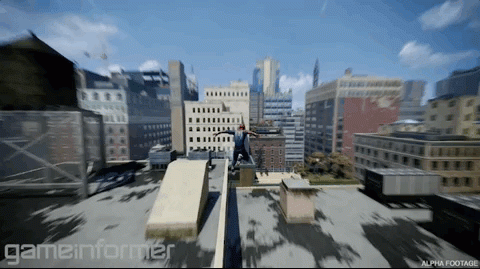
These are just some of the baseline maneuvers Insomniac introduced to us, promising that plenty of unlocks and upgrades will surface over the course of the game to improve his movement. Even with a Spider-Man who wasn’t fully powered up, though, moving through the world was incredibly fast, fluid, and fun.

Among Insomniac’s goals, when it comes to web-swinging specifically, is to make sure Spider-Man never slows down or stops. Combining web-swinging, web-zipping, the ability to pull into a full dive, and the assorted perch and launching options meant that once I got into the rhythm of movement, I felt unstoppable. Even actions like needing to make a sharp turn, or needing to turn around entirely, felt fluid and did not interrupt the flow of movement.
The perching goes a long way in making things flow and move without having to rely entirely on webs. Being able to mix up my actions and do more than just swing, and gain a lot of speed from doing more than just swinging, gave me a great sense of control over my movement. I wasn't just holding down a button and leaning on the control stick to move through the city – I was actively controlling Spider-Man. It didn’t take us long to start digging into the more complicated maneuvers, like using a web to round a corner as you parkour along the side of a building, and I cannot wait to see what I can pull off after spending hours with the game.
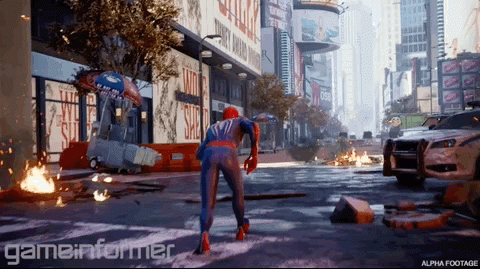
Update: There has been some interest in the button layout for web-swinging in Spider-Man from readers online, so we decided to add it to this story. Enjoy!
R2 - The button is contextual. It shoots out webs for swinging when you're in mid-air, or you can hold down the button to run along walls or perform parkour while on the ground.
X - Jump. You can also use it to exit a swing or press it at the top of a wall-run to leap over a building. Additionally, in mid-air, you can use it to web-zip to gain speed by shooting out a web in front of you. You can also hold the control stick in your desired direction, tap X to web-zip so Spider-Man can make sharp, or even U-turns.
L2 and R2 - Pressing L2 and R2 at the same time will make Spider-Man zip to a perch point, which are represented as white circles on the U.I. while you're swinging. You can leap from a perched position by hitting X, and if you do it quickly it does not interrupt your flow.
L2 - Holding down L2 makes everything go into slow motion so Spider-Man can aim for specific perches. This ability will likely lead to other maneuvers, but this was what we mainly used it for.
L3 - Holding down L3 makes Spider-Man go into a dive, which is perfect for gaining speed to enter a swing.
O - Holding down O while running to the corner of a building will make Spider-Man grab onto the side of the building with a web and make a sharp turn.
The Combat
Along with swinging through the city, we also got a chance to get into scuffles with assorted enemies. The combat is fast, aerial, and does not rely on extensive combos. Instead, it’s about managing the group around you, jumping between enemies, and dodging attacks with the aid of spider-sense. You build up a power meter to pull off finishers similar to the way you do in the Batman: Arkham games, and you can also work gadgets into the combat (which we will detail more in an online feature soon). Much like the web-swinging, there is an undeniable rhythm to fighting and it feels great. Spider-Man is an acrobat, and that aspect of his heroism feels properly integrated into his need to punch faces.
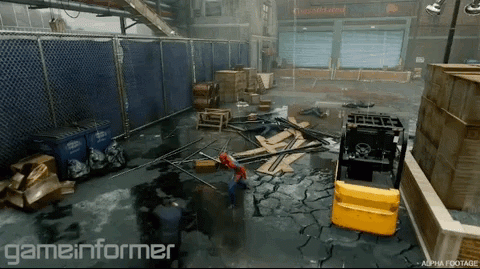
Spider-Man's animation is worth calling out specifically when it comes to combat. He moves with incredible speed and balletic grace and when you do pull off finishers, the camera moves in to show off slowed-down close-ups of what is happening. This isn't uncommon – slowing down the action to give players a better look – but I was particularly impressed with it in Spider-Man. Seeing the movements of his individual fingers as he pushed an enemy down to the ground in mid-air really gave a sense that nothing Spider-Man does with his body while in combat isn't a well thought-out maneuver.
Holding down the punch button launches enemies into the air, and throwing out webs to pull off swinging kicks is useful and encouraged. I was also impressed with the amount of environmental hazards integrated into every scenario. The most common one was grabbing an item (a barrel, a vent cover, a wooden pallet, etc.) with your webs and swinging it around your head to smash it into a single enemy. You could also pull of a similar maneuver with grenades to send them flying back where they came from.
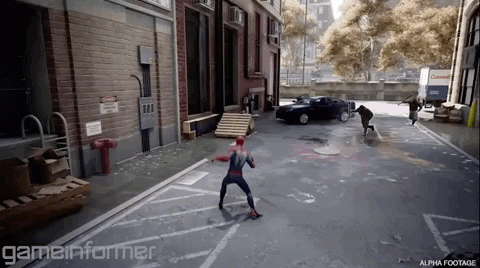
Spider-Man can also thrown out web shots to keep enemies in place, or web-zip over to them to close the gap. The latter move quickly became a favorite as I used it to keep the fight moving from enemy to enemy, and a way to get out of danger. If my spider-sense started tingling (denoted by an icon appearing around Spider-Man's head) I would use the zip to get out of the way of the danger and bring the fight to a new enemy. Staying mobile is key, and I had no problem keeping Spider-Man on his toes in every battle.
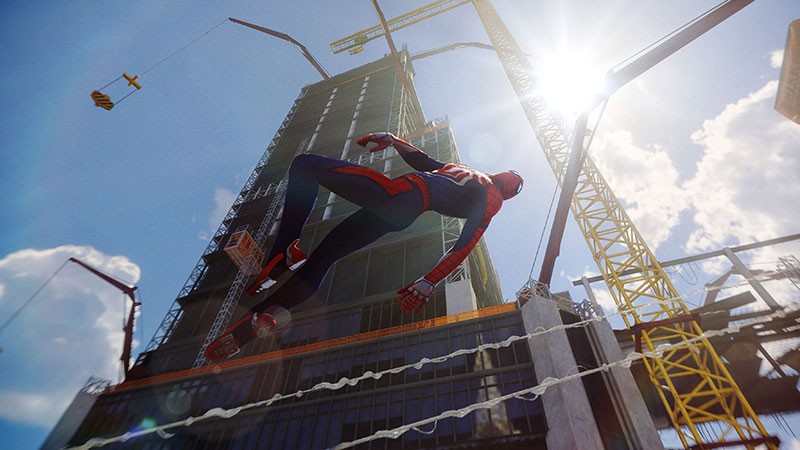
I admit some hesitancy going into my gameplay time with Spider-Man after seeing the E3 2017 gameplay footage. Despite being open-world, the gameplay shown seemed to be on rails, and I feared most of the game would feel rigid in that way. Those fears washed away immediately after getting my hands on the game. Both the web-swinging and combat offer impressive levels of player improvisation. I put down the controller feeling like I had truly taken control of the character, and I am eager to hone my web-swinging skills and see what talented players are able to do with him in September.
To see our entire month of Spider-Man coverage, click the banner below and bookmark our hub. New stories are added every couple of days, so check back to learn more about Insomniac's Spider-Man game.











